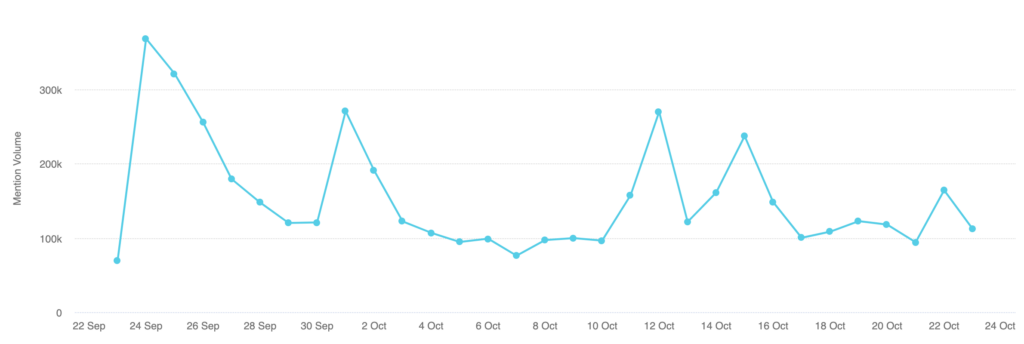
Mentions of “Taylor Swift over the past month on X.
To celebrate the release of “1989 (Taylor’s Version)”, we spoke with Andrew Ledbetter, Ph.D., professor and chair of the Department of Communication Studies, about Taylor Swift and big data.
Ledbetter tells the story of when he first became interested in Swift’s music around 2009, listening to “Love Story” on the radio, driving down the street in Lawrence, Kansas, thinking, “It was not the first time I heard Taylor Swift, but I thought yeah, I could be a fan.” Being a Swift fan is a visceral experience for him. He can remember where he was and what he was doing. While his family is now filled with Swifties, he says he is the “Original Swiftie.” He relates his fan experiences to what he sees happening in the fan community.
Big Data Era
Ledbetter admits when using the tools provided by the Schieffer Media Insights Lab, his first search is always “Taylor Swift” as a consistent variable in which to view media. According to Brandwatch, over the past month, mentions of Swift on X have reached 5 million total, with the highest spike on Sept. 24 when she was seen at a Chiefs game, sparking rumors about her relationship with Chiefs tight end Travis Kelce. This event had over 50K more mentions than when Swift premiered the Eras Tour Movie Oct. 11.
“When you ask why, big data can be supplemented with small data. In addition to the big data, where we can see these big events generate more social media activity than other big events, I would love to have small data. Have people complete a survey and see why exactly, what is on your mind or what do you think is on your mind as people post that information,” Ledbetter explains.

Word Cloud Depicting the most used words around the mentions of “Taylor Swift” in the past month.
This could help showcase Uses and Gratifications theory (UGT) as it gets to the core of what motivates people to post or search for this information online. Ledbetter also admits more research is needed on these kinds of relationships and the impact of social media.
“Having these connections with celebrities on social media is relatively new. It is not very long in human history that we have had this dynamic. We are wired to respond to people as people at a very deep level,” he said. “When we see human communication, even when it is mediated through a screen, we respond to that as human communication.”
Specific to the narrative around Swift and Kelce’s unexpected and public relationship, he said, “It seems like we are into unlikely pairings right now in pop culture. Most notably, Barbenhimer this year, where audiences paired two very different movies together. In some sense, Taylor Swift and the NFL are kind of like that. We think of those fan bases as being distinct and separate. But now they have collided.”
Read more about Ledbetter’s thoughts on Swift and communication theory, Communication Studies (Taylor’s Version).
Learn more about what data demonstrates about football fans on social media, Running the Numbers: Following the Data Flow of Frog Football.
